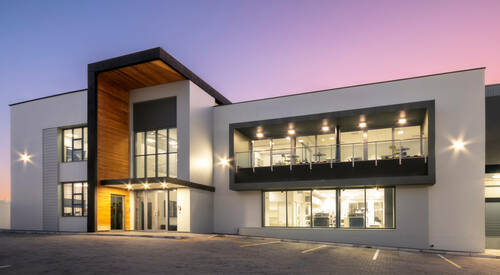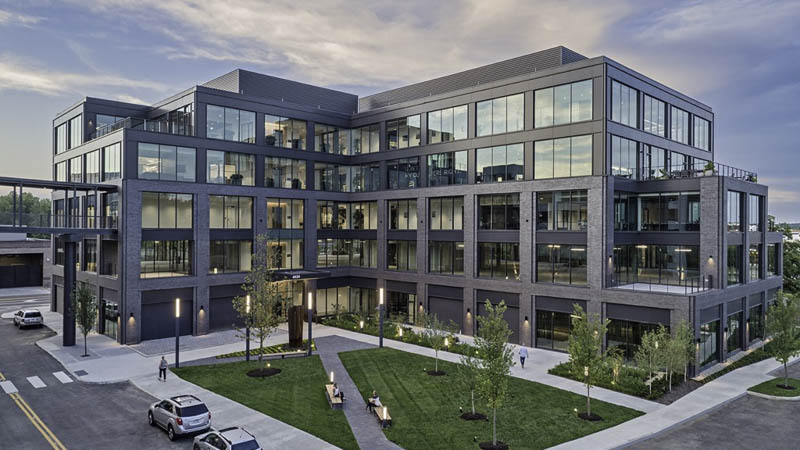Introducing the Comprehensive Providers Provided by Commercial Architects for Modern Dope
Commercial Architects offer a crucial function in contemporary development projects. They blend design visual appeals with functionality while adhering to regulative demands. Their expertise expands past plain building and construction, integrating sustainable techniques and innovative innovations. As they browse complicated zoning regulations, Architects work together with various stakeholders to bring visions to life. This complex method increases questions about the advancing duty of Architects fit modern areas and the impact of their service future developments.
Recognizing the Function of Commercial Architects in Modern Dope
In modern metropolitan landscapes, Commercial Architects play a vital role fit useful and aesthetic areas that satisfy varied business requirements. Their proficiency expands past plain design; they navigate complicated zoning regulations, constructing codes, and ecological regulations. By working together with customers, they identify specific requirements, making sure that each job aligns with the client's vision while likewise taking into consideration practical elements such as sustainability and cost-effectiveness. Commercial Architects are experienced at integrating ingenious innovations and materials right into their styles, improving both the performance and power effectiveness of structures. They conduct thorough website evaluations to evaluate the prospective difficulties and possibilities presented by a location. Additionally, efficient interaction with service providers and other stakeholders is vital, making sure that the task proceeds efficiently from conception to completion. Eventually, Commercial Architects contribute in producing rooms that not just meet functional functions but also add to the overall personality and vibrancy of urban atmospheres.
Idea Design: Changing Concepts Into Truth
Principle layout works as an important stage in Commercial architecture, where innovative layout solutions emerge from creative thinking. This procedure counts on joint ideation, bringing with each other diverse perspectives to fine-tune and improve first concepts. As ideas take form, they transform from abstract concepts right into substantial architectural realities.
Cutting-edge Layout Solutions
Changing concepts into truth is the hallmark of innovative layout solutions in Commercial design. These solutions mix imagination with capability, resolving the special needs of contemporary developments. By leveraging innovative innovations and lasting techniques, Architects craft rooms that are not only visually enticing but additionally reliable and adaptable. Focus on user experience drives the style process, guaranteeing that settings foster productivity and cooperation. Each project advantages from a tailored strategy, where concepts are diligently developed to mirror the client's vision while considering future patterns. Cutting-edge design services additionally prioritize adaptability, permitting for adjustments in time as service needs progress. Ultimately, these methods boost the general worth of Commercial spaces, making them crucial in today's competitive landscape.

Collective Ideation Process
Cooperation acts as the backbone of the ideation process in Commercial design, fostering creativity and innovation among varied stakeholders. Architects, customers, designers, and area members take part in vibrant conversations, making sure that all point of views are taken into consideration. This comprehensive technique enables the exploration of numerous layout principles, motivating distinct solutions that straighten with the project's vision. Via workshops and conceptualizing sessions, ideas evolve and fine-tune, transforming preliminary principles right into substantial layouts. Modern technology additionally plays a crucial duty, with tools such as Building Details Modeling (BIM) assisting in real-time collaboration and changes. Ultimately, this joint ideation process not just enhances the layout outcome but likewise cultivates a sense of possession and investment among all celebrations involved, leading to effective Commercial advancements.
Zoning Evaluation: Browsing Regulations and Conformity
As developers commence on brand-new projects, recognizing zoning regulations is important to making sure compliance and avoiding expensive delays. Zoning analysis plays an essential duty in this process, as it entails reviewing local zoning legislations that determine land usage, constructing elevation, thickness, and problems. Commercial Architects have the know-how to navigate these complicated laws, helping clients identify allowable usages and any required variations.
Sustainable Style Practices: Structure for the Future
Sustainable style practices are increasingly necessary in the domain of Commercial style, specifically as ecological issues continue to intensify. Architects focus on environmentally friendly products, energy-efficient systems, and layout approaches that minimize waste and environmental impact. Including renewable resource resources, such as photovoltaic panels and wind turbines, enables structures to create their very own power and minimize reliance on fossil fuels.Furthermore, sustainable design emphasizes the significance of indoor environmental quality. This includes utilizing all-natural light, boosting air flow, and choosing safe materials to enhance occupant health and efficiency. Environment-friendly roofs and living wall surfaces are likewise prominent attributes that contribute to biodiversity and metropolitan cooling.Additionally, Commercial Architects typically incorporate water preservation techniques, like rainwater harvesting and drought-resistant landscape design. Through these innovative strategies, they develop spaces that not only fulfill modern needs but likewise cultivate a sustainable future, resolving the expanding need for responsible growth in the modern-day globe.
Project Administration: Ensuring Timely and Effective Execution
Reliable job management is vital for ensuring that Commercial style jobs are finished on time and within spending plan. This duty encompasses an array of duties, consisting of the coordination of numerous stakeholders, timelines, and resources. Commercial Architects utilize their expertise to produce comprehensive task plans that lay out important turning points and deliverables, enabling methodical progress tracking.Regular interaction among team members and clients is crucial, promoting openness and helping with punctual decision-making. Risk monitoring methods are likewise utilized to identify prospective challenges early, allowing aggressive solutions to be established. By utilizing sophisticated job management tools, Architects can keep track of job performance in real-time, making adjustments as required to maintain effectiveness.
Interior Decoration: Creating Practical and Aesthetic Rooms
Interior why not check here style plays an essential function in boosting both capability and looks within Commercial spaces. Efficient room preparation can optimize process and boost user experience, while visual design principles add to a visually enticing setting - commercial architects. With each other, these components develop areas that are not only useful but likewise inspiring
Room Preparation Effectiveness
While taking full advantage of the energy of readily available room, Commercial Architects prioritize room preparation effectiveness to develop both practical and cosmetically pleasing settings. This strategy entails mindful evaluation of the spatial design to guarantee ideal use every square foot. Architects think about aspects such as process, availability, and natural light to enhance usability. By strategically putting furniture, devices, and workstations, they facilitate motion and interaction among customers, promoting productivity. In addition, zoning different locations for details features a knockout post helps in handling sound and privacy, developing a harmonious environment. With efficient area preparation, Commercial Architects can change restrictions into possibilities, guaranteeing that each area satisfies the diverse requirements of its occupants while sticking to regulatory needs and market criteria.
Visual Design Principles
Visual layout principles play an essential function in shaping environments that are not only useful yet also visually attractive. These principles lead Commercial Architects in developing areas that reverberate with individuals while enhancing brand name identification. Crucial element consist of balance, proportion, and consistency, which interact to produce a natural appearance. Color plans and products are meticulously chosen to evoke preferred emotions and sustain the total style. In addition, illumination plays an important role, influencing state of mind and presence while highlighting architectural features. By integrating these principles, Architects assure that rooms are not only useful however additionally inviting and motivating. Ultimately, efficient aesthetic style fosters a positive individual experience, encouraging involvement and fulfillment in Commercial settings.
Cooperation With Stakeholders: Promoting Successful Collaborations
Effective collaborations in Commercial style depend upon reliable collaboration with stakeholders, making sure that every voice is listened to and valued. This collective strategy involves engaging various parties, including customers, specialists, and area participants, throughout the style and advancement process. By cultivating open interaction, Commercial Architects can deal with concerns, collect insights, and straighten the task's vision with stakeholder expectations.The assimilation of diverse point of views improves imagination and discover this info here advancement, causing more practical and aesthetically pleasing designs. Regular meetings, comments sessions, and workshops facilitate this discussion, allowing Architects to adjust their plans in response to stakeholder input. In addition, developing trust fund via openness and accountability reinforces these collaborations, causing a smoother task execution.Ultimately, the success of contemporary developments relies on the Architects' ability to browse and balance differing rate of interests, developing a collaborative atmosphere that advertises shared objectives and shared success.
Often Asked Concerns
Just How Do Commercial Architects Take Care Of Budget Constraints Throughout a Task?

What Kinds of Software Do Commercial Architects Commonly Make Use Of?
Commercial Architects commonly utilize software such as AutoCAD for drafting, Revit for Building Details Modeling, SketchUp for 3D modeling, and task administration devices like Microsoft Task to boost collaboration and improve operations throughout the style procedure.
Can Commercial Architects Assist With Acquiring Financing for Projects?
Commercial Architects can help in acquiring financing for tasks by preparing in-depth proposals, helping to articulate design visions, and giving monetary forecasts that can enhance the chance of safeguarding needed funding from capitalists or banks.
Exactly How Do Architects Guarantee Safety And Security Throughout the Construction Refine?
Architects assure safety and security during building by executing strenuous style criteria, collaborating with designers, conducting normal site evaluations, sticking to local policies, and cultivating communication amongst all stakeholders to mitigate risks and promote a secure workplace.
What Recurring Support Do Architects Supply After Project Conclusion?
After project completion, Architects use ongoing assistance with maintenance appointments, performance evaluations, and design adjustments. They ensure buildings meet progressing requirements, address prospective problems, and maintain conformity with policies, fostering a long-lasting partnership with customers.